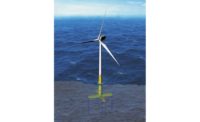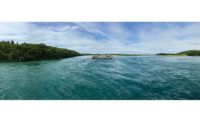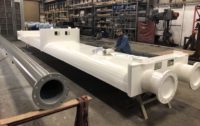The road to innovation can be a long and winding one, but it might be hard to rival the path followed by the Ocean Renewable Power Co., of Portland, Maine, and its RivGen submersible electric power generating system, which is designed for installation on riverbeds and is based upon the company’s tide-driven units for maritime locations.
On April 17, ORPC hosted the commercial product launch of the RivGen power system in Brunswick, Maine, to mark the impending delivery—for the third time since 2014—of a version of the system to a remote river community in Alaska. Except this time, rather than a test unit, a full-scale, submersible system is scheduled to be installed in the Kvichak River in June as a 35-kW power source for Igiugig, a village with a population of 80 located about 240 miles southwest of Anchorage.
The project is funded by a $2.3-million U.S. Dept. of Energy grant for development of hydrokinetic power units to help isolated communities like Igiugig wean themselves from diesel-powered generators. Diesel fuel is costly for such communities and is often difficult to supply.
With no road service, Igiugig is particularly isolated. The components of the system will have to be portaged multiple times by truck and barge to get to the site.
“It’s a great test case, because it’s exceptionally complicated,” says Monty Worthington, ORPC’s director of project development. “[If] we can get it there …we should be able to get most places, is what it comes down to.”
The RivGen system is built around the company’s patented submersible generator unit, which is driven by a pair of horizontally-oriented cross-flow turbines on a single driveshaft mounted on a pair of cross-braced pontoons. The power is transmitted by underwater cable to a shore side distribution system.
The 51.5-ft-long by 46.9-ft-wide chassis, or crib, is designed to be floated into place, restrained by anchored cables attached to the upstream ends, and then submerged by flooding the pontoons. Locally available vessels and contractors can reverse the process for retrieval and annual maintenance by pumping air back into the pontoons through a permanently installed umbilical cord and “self-deploying, self-retrieving” system.
The full assembly is 11.5 ft tall and weighs 32.5 tons. The total turbine capture area is 194 sq ft and it is designed for a maximum operational water velocity of 3.5 meters per second. The rated power output at that velocity is 80 kW, but the installation is expected to generate 35 to 40 kW in the more normal flow rate of 2.25 m/sec.
Historically, the river is ice-free in the area where the system will be deployed, although Worthington says the lake immediately upstream does freeze and releases its ice during spring thaws, but even then the ice breakup is expected to be thin enough that it is not expected to affect the submerged machine.
ORPC CEO Chris Sauer says “throughout North America, there are hundreds of communities that rely 100% on diesel. The challenge of delivering to remote areas jacks up the cost, yet most of these communities are sitting on very good river or tidal resources.”
Worthington says the last stage of delivery involves assembling the device in a lake upstream for about 10 days of testing of the deployment and retrieval system and other components before towing it to its final installation site.
By Tom Sawyer & Johanna Knapschaefer








Post a comment to this article
Report Abusive Comment